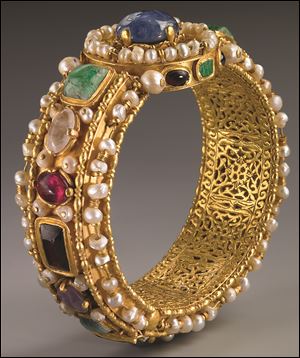
Exhibit showcases the lasting ingenuity of ancient metalsmiths
11/10/2017
A gold bracelet from the 6th century, part of the "Glorious Splendor" Christian art exhibit at the Toledo Museum of Art.
Metalsmith artist Hans Ruebel may live present-day, but when he creates pieces in his studio at the Toledo Museum of Art, it echoes the work of jewelry makers many centuries ago.
The ancient hammer and chisel techniques that shaped metal, stone, and gems into ornamental objects in the late Roman period between 2nd century B.C. and 7th century A.D. are revealed through the 30 pieces awaiting visitors in Glorious Splendor: Treasures of Early Christian Art. The exhibition, exclusive to Toledo, opens Saturday.
“Actually, many of the techniques you see in the exhibition are still used today,” Ruebel said. “I think it’s a matter of what was the most effective way to smooth metal or shape a stone. Once they figured out how to do that, we may have advanced our tools, but the techniques remain the same.”
Ruebel, who has a master’s degree in jewelry making, creates pieces using hammering, heating, and shaping techniques to forge decoration in metalwork. Those methods include chasing, engraving a metal from the front; repousse, hammering from the underside to create designs in relief, and granulation, using soldering and animal hide glue or other substances to attach and cover a surface with precious metal granules.
Additional programming related to the Toledo Museum of Art’s Glorious Splendor:
Treasures of Early Christian Art exhibition:
• 2 p.m. Dec. 2, curator talk, Adam Levine, Little Theater and Gallery 18
• 10 a.m. to 5 p.m. Dec. 8, colloquium, Late Antique Art and Local Micro-Identities, Little Theater
• 6-9:30 p.m. Dec. 15, film, Andrei Rublev (1966, 205 minutes), Little Theater
• Free Family Center Activities: Gems and Jewels, create a sparkly work of art using gems and jewels, noon to 5 p.m. Nov. 26 and Dec. 2, 10 a.m. to 3 p.m. Nov. 28 and 30, 3:30 to 8 p.m. Dec. 1.
• Treasure Boxes, decorate a box to contain gems, jewels, and other treasures, noon to 5 p.m. Dec. 10 and 15, 10 a.m. to 3 p.m. Dec. 12 and 14, 3:30 to 8 p.m. Dec. 15.
• TMA also offers jewelry making classes in its studios. For a complete list or more information, go to toledomuseum.org.
All of these methods were used in the elaborate busts, necklaces, bracelets, armlets, cameos, and other jewels in Late Roman history, a time also referred to as Late Antiquity.
“We have thermometers, we have all sorts of things that they didn’t have ... which makes it all the more amazing that such proficiency was achieved without our technology but with methods that are practically the same,” said TMA Associate Director Adam Levine, who is curating the show.
Ruebel, who has been the museum’s 3D studio manager for 17 years, overseeing the museum’s sculpture, blacksmithing, and jewelry studios, was asked to view the show’s pieces in advance and said it was “a pleasure to see such beautiful work. The quality of the work is exceptional. [Despite the similarities in technique], a metalsmith today would be hard pressed to recreate the pieces in this show.”
The pieces, the majority of which were drawn from private collections around the country, were crafted during Romes’s transition from a pagan society to a Christian one, and visitors will see objects with explicit Christian imagery including liturgical vessels but also styles consistent with pre-Christian material, Levine said.
Levine expects museum visitors to be dazzled by the show’s pieces, individually placed on mounts custom-made by museum staff to showcase not only the complexities of the jewelry but to give a sense of how the objects were worn in days long past. Jewelry makers of the day used diverse materials: solid gold, silver, extremely large, deep red garnets, emeralds, sapphires, pearls, and workable gemstones including jasper and sardonyx from India, Cyprus, and other places that traded with Rome.
The exhibition will include an educational space inviting visitors to learn more about the jewelry and the history of the time period, said Maria Iafelice, docent program manager for TMA.
Two objects in the show, Sardonyx Cameo Busts of Septimius Severus and Julia Domna, Set in a Gold Pendant (207-211 A.D.), and Red Jasper Cameo of Licinius I (317 A.D.), were replicated by Thingsmiths, Ann Arbor, using a 3D scanner to produce a solid-colored plastic composite that mimics the size and shape of the original pieces, she said. Some items weighed as little as a few grams, while others weighed heavily around the wearer’s neck or arm at up to 5 pounds.
“One of the really fascinating things about the objects in this exhibition is they were used, they were not display pieces, and it’s really because of the intricacies of them that we can’t have visitors hold these [actual] objects,” Iaferice said. “You will be able to hold [3D replicas] in your hand and physically feel the weight and the texture.”
Visitors will also be able to use monoculars to view details of the objects up close, and see photographs that show Ruebel implementing some of his ancient jewelry-making techniques.
“We talk about not only visual literacy but sensory literacy, so we are trying to ... have people engage their other senses, not just vision, to see what it meant to interact with objects like these in the antiquity,” Levine said.
The show closes Feb. 18.
Contact Roberta Gedert at rgedert@theblade.com, 419-724-6075, or on Twitter @RoGedert.